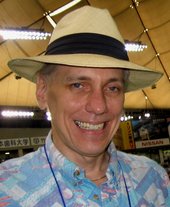
THE HOT CORNER: 'Boo' time comes again for Swallows

THE HOT CORNER: 'Boo' time comes again for Swallows
by Jim Allen (Apr 28, 2011)
So often, people miss the start of big things. Small hot streaks by unheralded players so often go unnoticed when there are so many other stories around. So it was last year with Kazuhiro "Boo" Hatakeyama.
The story of the 2010 Tokyo Yakult Swallows was the rags-to-riches playoff push by a club that had started so badly that its manager surrendered in May. The Swallows were scoring 3.13 runs per game with a 13-32-1 record when Shigeru Takada quit after a 3-2 loss on May 26.
Head coach Junji Ogawa took over, the Swallows started scoring 4.83 runs per game and went 59-36-3 from that point on to finish four games over .500.
Lost in that picture was Ogawa's finding room in his starting lineup for the defensively challenged Hatakeyama. Given an opportunity to play regularly for the second time in his career, he batted .310 with 14 homers, 16 doubles and 27 walks in 78 games under Ogawa.
"For a long time, we've known he could hit," Ogawa told the Hot Corner last Thursday. "The big question was finding a defensive position for him. We were in the minors together, so it is great to see him succeed at this level."
Ogawa started Hatakeyama, whose nickname roughly translates as "Tubby," in left field 48 times, while also giving him a few starts at first and third.
Hatakeyama began this season on the bench as well, while left-handed-hitting Josh Whitesell played first. Yet, after four straight losses to start this season, Ogawa shook things up and started Hatakeyama at first base. Boo picked up where he left off last year. He homered twice and drove in three runs in the Swallows' first victory. Five wins and one tie later, and Yakult was in first place.
After Sunday's games, the 28-year-old Hatakeyama was batting .393, leading the Swallows with a .471 on-base percentage and leading the league with a 1.000 slugging average.
Watch Hatakeyama take BP and it's a puzzle how he is able to maintain both his balance and hit, but he does. As he rocks back on one leg, his front foot taps, lifts and does a little figure eight before his body plunges, seemingly out of control, into the pitch. He looks like he shouldn't be able to stay back on breaking balls, but he is.
Five years ago, Hatakeyama demonstrated his ability as a 23-year-old minor leaguer, hitting .315 in 323 at-bats with 52 walks and 49 strikeouts. The following year, he raised his game another notch.
By 2007, Hatakeyama's minor league performance suggested he was already good enough to hit .300 at Jingu Stadium with 10-15 home runs a year and 50 walks. He broke through in the Central League in 2008, batting .279 with nine homers and 53 walks as a regular. But in 2009, Takada halted Hatakeyama in his tracks.
In order to put a better defense in the field, Takada made the promising 25-year-old hitter a part-timer.
Hatakeyama batted .227 and the Swallows' offense dropped by 35 runs.
Takada's drive to help his young pitchers develop by using the best available defense got the better of him when he sidetracked weaker fielders like his young heavy hitter Hatakeyama.
"I had been confident as a hitter, but I began to feel my playing time rested on the results of each at-bat," Hatakeyama said last summer. "I began to fear striking out, I became a defensive hitter."
This is a common problem when young players receive half-hearted opportunities. Quality hitters rarely make the adjustment to top-flight pitching without their share of ups and downs. It takes patience on the part of a manager, but that wasn't forthcoming from Takada in 2009.
Give 400 at-bats in the Central or Pacific league to a quality minor league hitter and he'll succeed. It was true of Ichiro Suzuki and Takeshi Yamasaki and Teppei Tsuchiya and Hatakeyama and Aarom Baldiris. It will be true of Yang Zhong-shou and Sho Nakata this year if the Fighters keep playing them every day.
If Ryota Arai miraculously manages to get 400 at-bats this year with the Tigers, people are going to wonder why the Dragons wasted the best years of his career in the Western League before selling him last winter to Hanshin.
For Hatakeyama, at least, it appears his days of wandering through the wilderness are over and he has finally arrived.
To access the original work (if still available), please reference:
http://www.yomiuri.co.jp/dy/sports/T110426004548.htm.
Back to the works of Jim Allen
This work is licensed under a Creative Commons License.
Some rights reserved.
